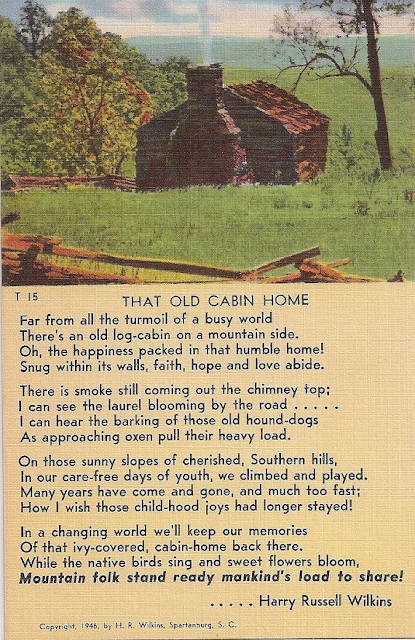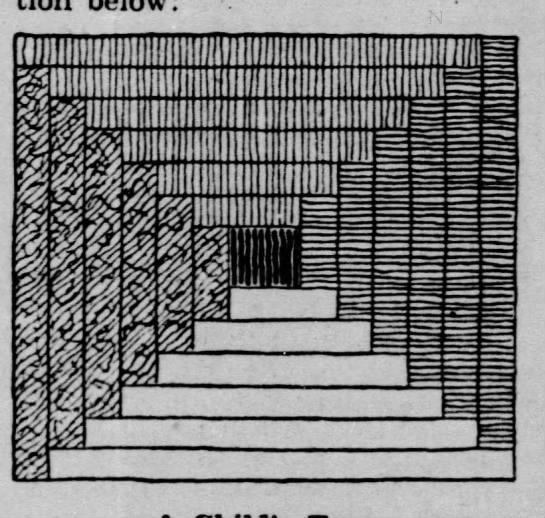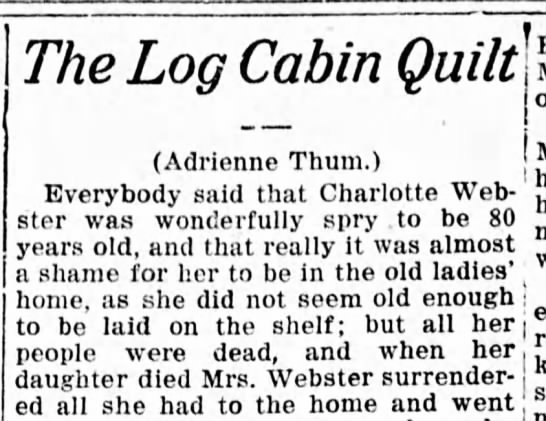In the U.S. and Canada, there are many homages to log cabins, a symbol of the pioneer spirit. In the U.S., most--if not all-- Log Cabin quilts were made after the death of President Lincoln.
In the early 20th century, a number of newspaper articles lamented what was considered the passing of the quilting era--and other things. The pattern they chose to focus on was the Log Cabin, it was the perfect choice to pull sentimental heart strings.
In 1900, one writer relayed:
"This week the writer saw a 'log cabin quilt' and it brought to mind the time of the lang syne. In memory comes the old Ohio home, with it's pleasant surroundings, its cheer in the sitting room, its large fireplace and the dear grandmother sitting in the chimney jamb. He sees her with her benignant expression, her snow what cap, her spectacles polished as bright as jewels, and her knitting in her hands." The writer remembers that once the evening was over, he was ushered to a nice feather bed covered with a log cabin quilt.
It sounds like an idyllic sweet memory. But there is a deeper meaning here. Nostalgia is often a rebellion against progress. A lot had changed by the early 20th century, not simply brought about by industrialization but by societal changes--in particular, women.
In the new (20th) century, it was clear women had become more independent. The Gibson Girl had become popular in the 1890s and represented the "New Woman": educated, athletic, and independent. So it may not surprise us to learn that some journalists called for a return to "normalcy" and even focused on how grandmothers were changing.
In 1902, one article began: "No bride has any business calling her trousseau complete unless she can boast of a real old-fashioned 'log cabin' quilt."
A 1906 article suggested that it was a difficult pattern to complete, the writer cited that silk log cabin quilts require "time and infinite patience to collect the materials and effect the actual manufacture of a 'log cabin' quilt, and that is probably why old ladies make them."
A different 1902 article lamented that elderly women no longer sewed. The writer irately noted that grandmothers no longer wore "'caps or even sunbonnets!" For these writers, the log cabin (house or quilt) was emblematic of a safer time period of folks in traditional roles. It was clearly time for grandmothers to maintain the writer's idealistic viewpoint on society and get to sewing.
"How many brides are to complete their trousseau without any specimens of grandmotherly needlework...There are no grandmothers to sew them..."
My favorite statement about the log cabin pattern was a description that made the quilt pattern seem otherworldly. The description of the finished quilt sounds almost spiritual because it presented an "aurora borealis of color".
The lament for the log cabin is interesting. It would be like someone now suggesting that everything that is wrong with society is due to not enough women quilting when the truth is so different. We're quilting today--and guess what--women were quilting in the early 20th century and making quilts.
County fair lists show an abundance of quilts entered and yes, log cabin quilts made. Many were made of wool and silk. Here is a cotton one of mine from the turn of the century:
In 1915, another writer mentioned that the quilt pattern was "no longer in vogue." An interesting insight: it was suggested that when the quilt pattern was popular, pieces of one's mother and grandmother's wedding dress were incorporated in the quilt.
Quilt historians often cite that quiltmaking was less popular in the early 20th century. But like the 1950s and 1960s, there were enough makers for us to collect examples. By 1911, Marie Webster's patterns were featured in Ladies Home Journal and a new wave of enthusiastic quilters were born. Sometimes I wonder if the "colonial revival" so popular in the late 19th and early 20th century wasn't also a just a call for "simpler times" but traditional roles and norms. The idea of elderly women as guardians of the domestic arts continued through the 20th century during the first quilt revival. Companies marketed patterns and kits with names like Grandmother Clark, Grandmother Dexter, and some "aunts".
Nostalgia is seductive and rarely bears any relationship to the truth. Most of all, it's not nice to blame anyone--especially grandma for the dissatisfaction one feels!
Have a safe and happy day!










No comments:
Post a Comment